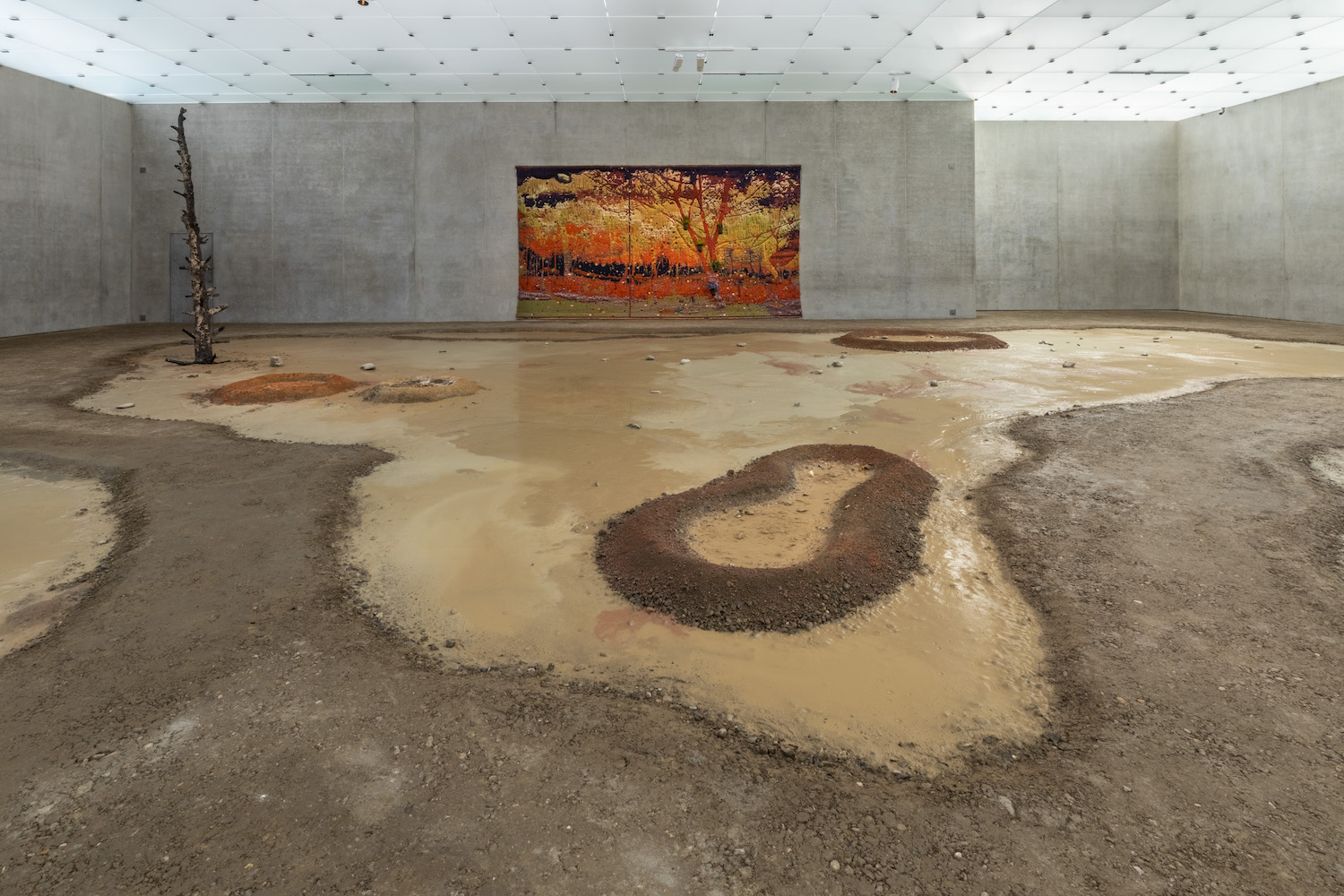The four breath-taking tapestries that Otobong Nkanga made last year in co-creation with the TextielLab are on display in Kunsthaus Bregenz in Austria until 6 March. The intensive collaboration paved the way for a unique acquisition. Nkanga is now working in the lab on a new textile that will become part of the TextielMuseum’s collection.
In Kunsthaus Bregenz, a tree appears to grow through the building’s four floors. The exhibition rooms have been transformed into landscapes, which serve as a backdrop for artist Otobong Nkanga’s fascinating but oppressive narrative about earth and water. The 6 by 3.5-metre tapestries on each floor, which Nkanga developed in the TextielLab in 2021, also depict human destruction of nature and the pressing social issues associated with life on earth. The series is called ‘Unearthed’. The story begins on the ground floor at ‘Abyss’, in the deepest recesses of the ocean. As you climb the stairs, the scenes get lighter, ending on the top floor with the tapestry titled ‘Sunlight’. Here, the scorching sun causes the mud floor to dry out and crack a little more each day. “The apotheosis gave me goosebumps,” says Suzan Rüsseler, curator of art and design at the TextielMuseum. “The tapestries are breath-taking. The textiles are visually stunning but at the same time full of political references. They refer to the climate crisis, the loss of human labour and the legacy of extractivism: the relentless extraction of raw materials from the ground for financial gain.”

Unearthed, Sunlight in Kunsthaus Bregenz. Photo: Markus Tretter
More depth
Much of what is displayed in ‘Unearthed’ was developed organically on the TextielLab’s newest loom, in co-creation with master weaver Stef Miero. In the spring of 2021, Nkanga’s project was the first to be produced on the impressive 3.5-metre-wide machine. As a token of appreciation for the intensive exchange of expertise and craftsmanship, she embroidered the names of the lab and master weaver on the back of the tapestries. Says Rüsseler, “Otobong herself indicated that her fabrics have gained more depth in the 12 years since she first came to work with Stef Miero. By better understanding what you can do with yarns and weaves, and trying out different things together on the spot, the work became increasingly refined and layered.”
“Otobong herself indicated that her fabrics have gained more depth in the 12 years since she first came to work with Stef Miero. By better understanding what you can do with yarns and weaves, and trying out different things together on the spot, the work became increasingly refined and layered.” – Susan Rüsseler, curator
New collection piece
The intensive collaboration resulted in more than four tapestries for Bregenz; the project paved the way for a new piece for the TextielMuseum’s collection. “We can’t normally buy work from artists in the highest echelon because we simply don’t have the budget,” says Rüsseler. But by exchanging services, the museum was able to obtain a work by the internationally renowned Nkanga. The lab provided machines, materials, time and knowledge for the four tapestries. In return, Nkanga is making a new tapestry for the museum. “This wouldn’t have been possible without the generous gesture of the artist, with whom the lab has built a close working relationship over the years.”
The design for the new tapestry by Otobong Nkanga for the TextielMuseum
Cultural entrepreneurship
Rüsseler describes the exchange as a new form of cultural entrepreneurship, which could make it possible to purchase other works by renowned artists. She sees this project as an initial exploration of ways to expand the limited purchasing budget. In any event, the museum’s purchasing policy is broader than that: with the support of the Mondriaan Fund, the museum commissions two artists every year to create new pieces for the collection. Raquel van Haver, Ada M. Patterson, Asli Hatipoglu and Alydia Wever & Ryan Oduber have already been commissioned for the next two years. “We want to focus more on themes such as inclusion, cultural diversity and polyphony,” says Rüsseler. “These artists’ work – just like Otobong’s – closely fit these themes.”
Life cycle
The new design will be completed in the TextielLab at the end of January. Thematically, it further develops and condenses ‘Unearthed’, in which Otobong made use of previously gained experience and techniques. This time, the work will not be a series of linked pieces but an entire story in one tapestry: a landscape that depicts the life cycle and expresses the hope that even in death there is a possibility for new life. “Like the tapestries in Bregenz, this particular work is also about energetic processes,” says Rüsseler, “from the micro to macro level, physical, mental and cultural-political.” How this translates into textile can be seen in the spring 2023 exhibition in the TextielMuseum. And of course, the work will have a proud place in the collection.
In the video above, Otobong Nkanga, expert weaving Stef Miero and head of TextielLab Hebe Verstappen talk about TextielLab’s new weaving machine that was presented for the first time at Kunsthaus Bregenz 2021.